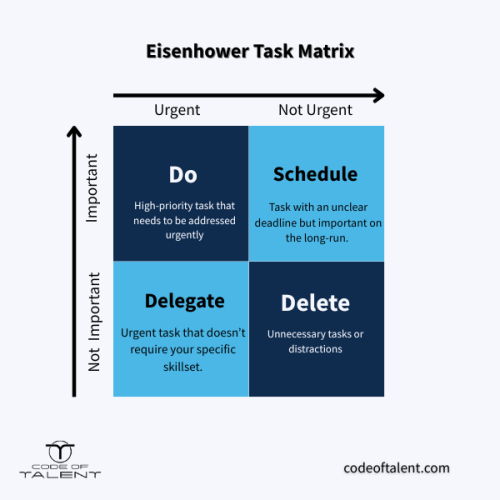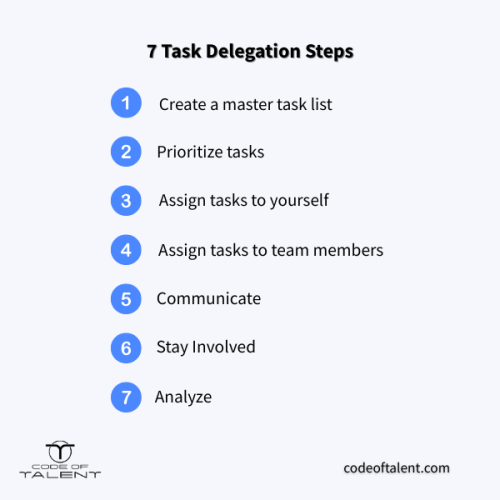An inbox flooded with red-flagged emails is a nightmare for any manager, especially when you’re a new manager. The pressure to take on everything yourself is high. You want to prove yourself or don’t want to overburden your team. And before you know it, you’re exhausted and frustrated. This is when many realize the hard truth: learning how to delegate as a leader is a survival skill in the world of management.
Delegation is at the core of what it means to manage: it’s right there in the job title. A manager’s role is to balance workloads across the team, based on each person’s strengths and team’s shared goals.
And it’s not just good for people but for the business too. Gallup found that CEOs with strong delegation skills achieved a staggering 1,751% growth over three years and generated 33% more revenue. This meant 112 percentage points higher than their less-delegating peers.
Yet despite its impact, delegation is one of the most overlooked leadership skills. Many assume it’s something you learn “on the job” during moments of crisis. But modern leadership training techniques now allow managers to practice delegation in ways that mirror real-time work environments.
This article breaks down why knowing how to delegate as a leader is crucial for your success, your team’s morale, and your company’s growth. We’ll explore how to do it effectively and how leadership development can turn this skill into your greatest strength.
Why It’s Important to Know How to Delegate as a Leader
Many managers struggle to delegate—not because they lack ability, but because of psychological barriers, such as:
- “I can do it faster myself.”
- “I’m the only one who knows how to do this right.”
- “If I give people too much work, they’ll resent me.”
- “What if they mess up and I’m held responsible?”
These beliefs are normal but also limiting. Learning how to delegate as a leader means challenging these mindsets and replacing them with a more analytical, objective approach.
Direct Consequences of Improper Delegation
When you don’t know how to delegate as a leader, the fallout can affect not just your workload, but your credibility, team dynamics, and overall performance. Common consequences include:
- Taking on too much work yourself
- Overloading some people on your team and underutilizing others
- Missing on delivering tasks because you prioritized the urgent ones
- Losing control of the situation
- Damaging your reputation as a competent manager
- Decreasing employee engagement and organizational growth, according to research published in the Global Social Sciences Review
- Provoking passive-aggressive resistance when employees feel managers only delegate tasks they want to avoid, per University at Buffalo research.
- Losing influence over the team when others start making key decisions instead of you
Why Delegating Helps You, the Manager
As a team leader, you’re expected to wear many hats: assigning tasks effectively, guiding the team through challenges, taking responsibility for both success and failure, and supervising everything from missed deadlines to quality issues.
Simply put, the pressure is high. This is why knowing how to delegate as a leader can:
- Prevent burnout: A 2024 survey found that 51% of U.S. employees reported experiencing burnout in the past year. When managers take on too much, they risk exhaustion and, eventually, quitting the role altogether.
- Help you focus on what matters: Delegation allows you to concentrate on tasks like strategic thinking and mentoring your team.
- Improves your credibility: Delegating signals confidence and trust. Leaders who don’t delegate appear insecure or controlling.
Why Delegating Helps Your Team
Team members look to their managers for organization, foresight, and genuine concern for their well-being and development. When done right, delegation empowers your people. Here’s how effective delegation supports the team:
- Clarifies roles and responsibilities: When employees know exactly what’s expected of them, they’re less likely to make mistakes. A Workplace Peace Institute survey identified lack of role clarity as the third leading cause of workplace conflict.
- Accelerates skill development: Delegating a diverse range of tasks gives team members the chance to learn new skills and expand their capabilities.
- Builds their accountability: Assigning responsibility communicates trust. According to Harvard Business Review, when employees take ownership over their work, productivity, morale, and commitment all increase.
- Better team collaboration: Harmony within the team starts with a well-organized leader. When tasks are clearly assigned, team members know who to turn to, how to help, and how to align their efforts toward shared goals.
Developing Delegation with Leadership Training
Leadership training has become a top priority in recent years. According to Harvard Business Publishing’s 2024 Global Leadership Development Study that surveyed over 1,100 learning and development (L&D) professionals across 15 countries, 70% of respondents emphasized the importance of leaders mastering a broader range of behaviors to meet current and future business needs.
Delegation is one of those behaviors, as this is a learned skill, not an instinct. And the right leadership training can help managers build this skill effectively.
What Great Delegation Training Should Offer
Leadership training comes in many formats, but impactful programs share common traits that help managers learn how to delegate as a leader more effectively:
Real-World Simulations and Delegation Exercises
Immersive simulations that mimic high-pressure situations teach managers how to assign tasks under time constraints. These safe environments allow leaders to practice decision-making and delegation techniques without real-world consequences.
On-the-Job Training
Managers often lack time for lengthy training sessions. Platforms that use microlearning, which offers short, focused lessons accessible via desktop or mobile, allow learning to fit into any schedule. This model helps managers absorb information when needed, without intervening with their workday.
Peer Collaboration
Microlearning or e-learning platforms also allow managers to observe how others approach delegation challenges, give and receive peer feedback, and work on their communication and evaluation skills. This way, managers can learn from other managers (new or experienced).
Personalized Development Journeys
Every industry has its hardships. A retail store manager deals with different struggles than a construction team lead. With customizable training journeys, content is relevant, actionable, and aligned with specific job functions.
General Tips for Delegation
Delegation takes time and practice to master. A manager will find different strategies to manage workload as they gain more experience, learn more about their team, and how they can behave as a leader. However, great delegation practices require general tips that challenge the psychological triggers mentioned above.
1. Learn When to say “No” and “Yes”
It’s ok to put off some tasks for later and prioritize other, more urgent ones. It’s ok to even ask for a deadline extension if you seem fit and it’s possible. Learn how much is too much for your team and ask for help from upper management if needed. You would rather be judged by not speaking up than missing a deadline.
2. Learn What to Delegate
Not all tasks are urgent and important. Knowing how to classify tasks according to their priority is the starting point of any delegation practice. Ranking tasks according to importance builds your team’s to-do list in a cohesive and logical way. You can use the Eisenhower Matrix for task classification as such:
- Urgent + Important = Do it now
- Important, not urgent = Plan to do
- Not important but urgent = Delegate
- Neither = Eliminate or assign

3. Have a Task Management System
Whether it’s a shareable Google Spreadsheet, a project management platform, or a to-do list in your team’s chat app, have a system of tracking activity for every project. Write down the tasks, people assigned, due date, and status. Team members are updated in real time of the progress, and you have visibility of the progress.
7 Steps to Delegate Effectively
Follow these seven practical steps to delegate in a structured and sustainable way.

1. Create a Master Task List
Start by listing everything that needs to be done. Don’t worry about order—just capture each task along with any helpful notes, such as deadlines, required skills, or client-specific guidelines.
2. Prioritize, Using the Eisenhower Matrix
Sort tasks by urgency and importance. Even if you don’t have time to organize everything, start with the most urgent ones. This helps clarify what needs immediate attention and what can be delegated or scheduled.
3. Choose What You’ll Handle Personally
Simplify the process by defining your own responsibilities. Consider your availability, the strategic value of your time, and the management duties only you can fulfill. Then determine what can be passed on to others.
4. Match Tasks to Team Members
Think about each person’s skills, experience, and current workload. High-stakes tasks may require someone with strong decision-making abilities, while repetitive or routine tasks can be ideal for less experienced team members.
5. Communicate Expectations Clearly
When assigning tasks, explain the scope, goals, and timelines. Make sure the team has access to all resources, including your task management system. Most importantly, create space for questions and concerns.
6. Stay Involved
Delegation doesn’t mean stepping away. Keep oversight by holding regular check-ins, offering support, and being available when problems arise. Your presence helps prevent misunderstandings and builds team trust.
7. Reflect and Improve
After the project is complete, review how the delegation went. What worked? What didn’t? Use these insights to refine your approach next time. This improves the process over time.
Stop Being the Bottleneck and Start Being the Bridge
Delegation is more than a time-saver. It’s a leadership skill that drives performance, growth, and team trust. At Code of Talent, we provide a microlearning platform that equips managers with the tools and mindset needed to delegate effectively, without overwhelming their day.
Explore Code of Talent’s free trial on upskilling training and see firsthand how to delegate as a leader with confidence and impact.
Cover photo: Freepik





